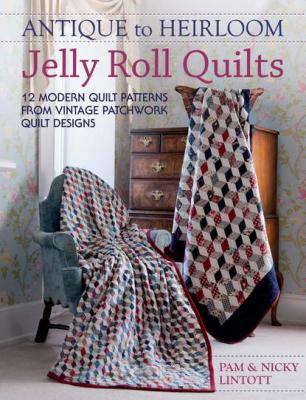Antique To Heirloom Jelly Roll Quilts. Pam Lintott
Читать онлайн.| Название | Antique To Heirloom Jelly Roll Quilts |
|---|---|
| Автор произведения | Pam Lintott |
| Жанр | Сделай Сам |
| Серия | |
| Издательство | Сделай Сам |
| Год выпуска | 0 |
| isbn | 9781446361764 |
9 Now sew the rows together, pinning at every intersection. Sew the corner triangles on last and trim them to size if necessary.
Finishing the Quilt
10 The quilt top is now complete. Prepare the top, wadding (batting) and backing fabric for quilting and quilt as desired – see Quilting in General Techniques. Bind the quilt to finish, following the instructions in Binding a Quilt.
To make a scrappy binding take the eight jelly roll strips allocated for the binding and cut each into four rectangles approximately 21⁄2in × 101⁄2in. Sew them into a continuous length, trying not to have two rectangles of the same fabric next to each other.
Chain Reaction
Antique Inspiration
This wonderful quilt was made in America during the 1930s. It uses a triple Irish Chain layout made with 1in squares and is totally hand sewn and hand quilted – even the calico background was cut into 1in squares and sewn together! It certainly is a labour of love. This antique quilt measures 72in × 92in (183cm × 234cm).
Quilt making was undergoing a major resurgence during the 1930s. In 1933 the World’s Fair was held in Chicago, USA to celebrate the city’s 100th anniversary and a century of progress. It has been estimated that an amazing twenty million people attended this fair. As part of the event Sears, Roebuck and Company, America’s largest retailer at the time, sponsored the Sears National Quilt Contest, offering total prize money of $7,500. This was an enormous sum of money, especially during a time of recession, and not surprisingly they had 25,000 entrants. The winning quilt was called Star of the Bluegrass and was awarded $1,000 prize money. Having judged the Jelly Roll Dream Challenge we find it hard to imagine the enormity of this event and it shows just how popular quilting was during this time, despite the terrible economic conditions.
Today’s Heirloom
The antique quilt was our inspiration but for our modern heirloom we decided that while honouring the design layout of the original quilt we would choose a totally different colour plan. We wanted to use the vibrant colours and extrovert patterns of designer Kaffe Fassett and these fabrics just called out for a dark background to emphasize them. The result is a bold and striking creation that would work well with many contemporary interiors.
Working with the jelly roll, our squares increased to 2in and we decided that our background fabric really didn’t need to be cut into 2in squares as they could be created from variously sized larger rectangles. The quilt went together very easily and was quick and simple to sew together thanks to some clever strip piecing. The quilt was made by the authors and longarm quilted by The Quilt Room.
Chain Reaction Quilt
Vital Statistics
Finished Size: 76in × 76in
Block Size: 12in square
Number of Blocks: 36
Setting: 6 × 6 blocks plus 2in border
Requirements
• One jelly roll OR forty 21⁄2in wide strips cut across the width of the fabric
• 23⁄4yd (2.5m) of fabric for the background and the border
• 11⁄2yd (1.4m) of accent fabric
• 24in (60cm) of binding fabric
Cutting Instructions
Jelly roll strips:
• Cut all forty jelly roll strips in half to create eighty rectangles measuring 21⁄2in × 22in approximately.
Accent fabric:
• Cut twenty 21⁄2in strips across the width of the fabric and cut each in half to create forty rectangles approximately 21⁄2in × 22in.
Background fabric:
• Cut thirteen strips 21⁄2in wide across the fabric width.
• Set eight aside for the borders.
• Cut the remaining five in half to create ten rectangles approximately 21⁄2in × 22in.
• Cut five 41⁄2in strips across the width of the fabric and cut each in half to create ten rectangles approximately 41⁄2in × 22in.
• Cut five 61⁄2in wide strips across the fabric width and cut each in half to create ten rectangles approximately 61⁄2in × 22in.
Binding fabric:
• Cut eight 21⁄2in wide strips across the width of the fabric.
Sorting the Strips
• After cutting your fabrics, make five separate piles as follows.
• Eighty jelly roll rectangles.
• Forty accent rectangles.
• Ten 21⁄2in wide background rectangles.
• Ten 41⁄2in background rectangles.
• Ten 61⁄2in background rectangles.
Sewing Strip Unit A
1 You now need to make three different Strip Units – Strip Unit A, Strip Unit B and Strip Unit C, as follows. For Strip Unit A choose three jelly roll rectangles, two accent rectangles and one 21⁄2in background rectangle and sew them into Strip Unit A as shown in the diagram below. Do not spend too much time on your selection. A good policy is to use what is next in the pile unless it is just too similar. Press the seams as shown. Repeat to create a total of ten Strip Unit As.
Strip Unit A - make 10
2 Lay one Strip Unit A on the cutting mat at a time. Trim the selvedge and subcut into eight 21⁄2in segments. Always line up the markings on the ruler with the seams to make sure
